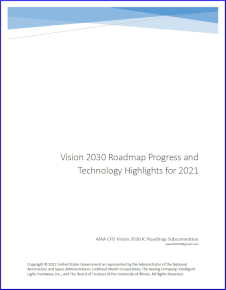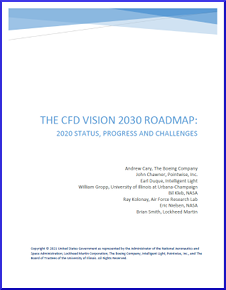The CFD Vision 2030 - Roadmap Update Reports
Vision 2030 Roadmap Progress and Technology Highlights for 2021
Abstract
In 2021, the AIAA CFD Vision 2030 IC Roadmap subcommittee released a report reviewing progress and challenges associated with the technology items identified on the Roadmap from its initial release through 2020. This document identified that while significant progress had been made on key technology demonstration items, many of the original milestones were behind schedule. With some of the findings since 2014, some of these milestones are less critical at present and new items of study have been identified. This report was followed by a companion paper [2] presented at AIAA Aviation that provided an updated Roadmap with shifted milestones and the addition of new technology milestones as well as enhanced Domain definitions. This paper also provided a TRL level scale to measure technology development appropriate for this type of community-level activity and performed an initial assessment of the tasks. More detailed descriptions were also provided to assist in quantifying progress.
- Vision 2030 Roadmap Progress and Technology Highlights for 2021
- Download PDF from cfd2030.com.
- Authors and Affiliations
- Andrew Cary, The Boeing Company
- John Chawner, Cadence Design Systems
- Earl Duque, Intelligent Light
- William Gropp, University of Illinois at Urbana-Champaign
- Bil Kleb, NASA
- Nathan Wukie, Air Force Research Lab
- Eric Nielsen, NASA
- Brian Smith, Lockheed Martin
Full Report: The CFD Vision 2030 Roadmap: 2020 Status, Progress and Challenges
Abstract
The CFD Vision 2030 Study (referred to hereafter as Study) contracted by NASA was published in 2014 and has become an aspirational objective for focusing CFD development areas toward aerospace applications. This Roadmap identified the six main technical domains for aligning research as high performance computing (HPC), physical modeling, algorithms, geometry and grid generation, knowledge extraction, and multidisciplinary analysis and optimization (MDAO), with subtopics within each of these maturing from 2015 to 2030. These maturing technologies target the application of CFD to aerospace applications of increasing complexity through 2030. Development of these techniques is fundamental to the successful execution of a series of grand challenge problems. The grand challenge problems are a stepping stone to routine application of CFD to an array of design and development problems with significantly expanded scope and complexity.
Recognizing the ongoing utility of the Roadmap toward improving CFD technology, AIAA formed an Integration Committee around this vision. One of the charters of this committee is to maintain recognition of the Roadmap and highlight the ongoing aerospace CFD research needs. Shortly after a 2019 Aviation session reviewed the status of the Roadmap, a team was formed to provide a more detailed technical review of the Roadmap and identify progress with (and challenges to) following the outlined trajectory. This Report presents a summary of the developments through 2020 related to the technical elements in the Roadmap. While this Report cannot be exhaustive and surely some elements have been omitted, it includes inputs from a group of experts with extensive background in the diverse disciplines represented in the Study. In addition to the authors, other key contributors are acknowledged at the end of the document. Overall, significant progress has been made toward the Vision, but many areas are behind the schedule forecast in the original Study. Several elements and technologies that influence the Roadmap have emerged in the last five years, such as machine learning for turbulence modeling. Relevant technologies that were not included in the original version have been identified. Each of the six domains are reviewed in detail, both for 2020 accomplishments and for overall progress on the milestones identified in the Study.
- The CFD Vision 2030 Roadmap: 2020 Status, Progress and Challenges
- Download PDF from cfd2030.com.
- Cary, A., Chawner, J., Duque, E., Gropp, W., Kleb, W., Kolanay, R., Nielsen, E., and Smith, B., “CFD Vision 2030 - Roadmap Updates,”, URL: http://www.cfd2030.com/report, 2021.
- Authors' Affiliations
- Andrew Cary, The Boeing Company
- John Chawner, Pointwise, Inc.
- Earl Duque, Intelligent Light
- William Gropp, University of Illinois at Urbana-Champaign
- Bil Kleb, NASA
- Ray Kolonay, Air Force Research Lab
- Eric Nielsen, NASA
- Brian Smith, Lockheed Martin
Technical Paper: CFD Vision 2030 Road Map: Progress and Perspectives
A technical paper was published and presented at AIAA Aviation 2021 that provided an overview of the full 2020 update report.
- Link to paper download from Aerospace Research Central: AIAA 2021-2726
- Cary, A., Chawner, J., Duque, E., Gropp, W., Kleb, W., Kolonay, R., Nielsen, E., and Smith, B., "CFD Vision 2030 Road Map: Progress and Perspectives," AIAA paper no. 2021-2726, Aug 2021, https://doi.org/10.2514/6.2021-2726.
Abstract:
The CFD Vision 2030 Study, contracted by NASA, was published in 2014 and has become an aspirational objective for focusing CFD development on aerospace applications. The Study identified six main technical domains for aligning research: high performance computing (HPC), physical modeling, algorithms, geometry and grid generation, knowledge extraction, and multi-disciplinary analysis and optimization (MDAO). Within each domain, sub-disciplines (aka elements) illustrate the maturation of technology during the time period from 2015 to 2030. Each of the elements have their own timeline to identify key technology milestones and technology demonstrations. This Roadmap provides a compact and informative summary of future objectives and milestones, but some details are necessarily omitted from the graphic due to space constraints. These maturing technologies target the use of CFD for aerospace applications of increasing complexity which are represented in the Study by a series of grand challenge problems. At the 2019 AIAA Aviation forum, five years after the Study was published, a special session was held with invited lectures reviewing the progress and future in the six domains. Recognizing the ongoing utility of the Vision toward improving CFD technology, AIAA formed the CFD 2030 Integration Committee (IC). One of the charters of the IC is to maintain the Roadmap by assessing progress and highlighting the ongoing needs of aerospace CFD. Shortly after the 2019 Aviation Forum special session, the IC formed a Roadmap subcommittee to provide a detailed technical review of the Roadmap and identify progress with (and challenges to) following the outlined trajectory. The Roadmap subcommittee released a report in June of 2021 with their findings to provide further guidance to the research community. While this report cannot be exhaustive and there are likely some elements omitted or inadvertently neglected, it represents inputs from a diverse group of experts in the field. This paper describes the approach taken, summarizes the findings, and provides an update to the Vision 2030 Roadmap reflecting the present understanding.
Roadmap Graphics
More Information
There will be annual tracking of progress toward the milestones and your assistance would be welcomed. For more information, contact the AIAA CFD Vision 2030 Integration Committee at aiaacfd2030@gmail.com.

